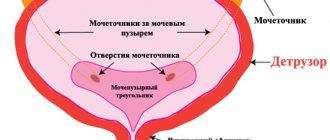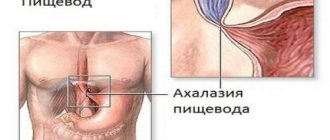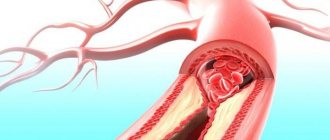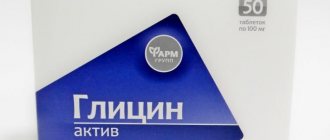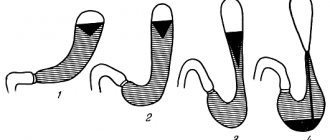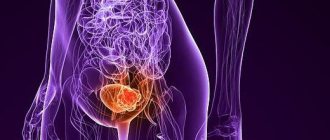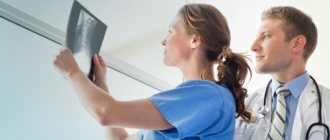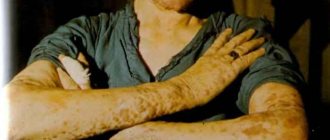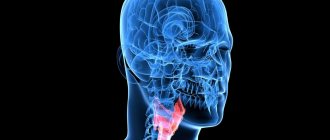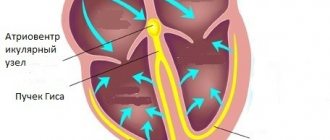People remember the health of the gallbladder much less often than, for example, the stomach or intestines. However, the importance of this organ is underestimated. Together with the liver, it participates in detoxification and also produces enzymes necessary for the complete digestion of food.
One of the pathological conditions that often occurs is the bending of the neck of the gallbladder. Such a deviation leads to stagnant processes and impaired motor skills, negatively affecting a person’s well-being.
What is inflection
What is a gallbladder bend? To understand what pathology is, you need to remember how the organ works.
Outwardly, it resembles a pear; the bubble consists of three parts:
- bottom;
- body;
- neck.
On one side, the gallbladder is connected to the liver, this happens through the cervix. As a result, a channel is formed through which bile flows. The process of bile circulation occurs continuously. If the organ functions normally, the liver, intestines, and stomach receive an amount of bile that is sufficient to digest food and other natural processes.
Deformation or curvature of an organ occurs for various reasons. Depending on which area has undergone undesirable changes, the type of disease is also distinguished. In some cases, a twisted gallbladder is a congenital pathology, but more often it has an acquired form.
Often congenital inflection is a pathology acquired during the first trimester. Among the causes are infectious diseases suffered by a woman after conception and bad habits.
Structure and functions of the gallbladder
It is known that the gallbladder is directly involved in the process of processing and assimilation of food. Anatomically, it is part of the liver, its main function is the accumulation and thickening of incoming bile.
Interesting. In its normal state, the gallbladder resembles a pear-shaped sac, no more than 10 cm in length and 3–3.5 cm in diameter, capable of holding 40–60 ml of fluid.
The widest end of the organ, adjacent to the wall of the abdomen, is called the bottom, and the narrower end is called the neck. In the middle is the body, in which liver secretions accumulate. Due to the appearance of screeds, the bubble takes on a pathological shape and ceases to function normally. The result of bending is a deterioration in contractility and stagnation of bile.
Deviations from the norm can be seen during an ultrasound examination
Kinds
There are several options for classifying pathology, depending on the type of development it is:
- temporary - functional;
- constant - persistent, fixed bends.
The permanent form of kinks of the gallbladder is more common. The main classification, which allows diagnosing pathology and selecting treatment, is associated with the location of the inflection. Pathology can affect:
- bending of the body;
- necks;
- bottom;
- duct between the bladder and the liver.
An inflection in the body and bottom of the gallbladder is less common; damage to the neck of the organ is more often diagnosed. At the same time, the size of the cervix changes, so the pathology is easy to diagnose by ultrasound. A gallbladder with a bend in the body quickly loses its functionality, the outflow of bile is disrupted, so this type of pathology is considered the most dangerous.
Depending on the shape of the bend of the gallbladder, the degree of development of the pathology is determined. The organ can be bent into the shape of an arc, an hourglass, or a hook. There is also an S-shaped or double bend, which results in double torsion of the organ. Usually one bend is diagnosed, less often two; more is extremely rare.
Fact. An S-shaped bend is often found among the congenital form of the pathology.
Photo
The photo below shows different types of pathology, in which the bladder is twisted in different places. And it is also shown, using the example of torsion in the cervical area, what a healthy and changed organ looks like.
Symptoms of bending in adults
Symptoms of gallbladder deformation may not be obvious at first; sometimes a person finds out about the presence of pathology by chance, while doing a routine ultrasound of the internal organs. As the bend develops, some signs appear. Unfortunately, as pathology progresses in adults, its symptoms are often confused with other diseases and left unattended.
Gallbladder congestion
With the development of deformation of the gallbladder, the following often appear:
- pain in the abdominal area, which is aching in nature, can radiate to the area of the scapula and collarbone on the right side;
- nausea, frequent vomiting;
- constipation or diarrhea;
- bitter taste in the mouth due to impaired bile flow;
- belching, heartburn;
- staining of urine in very dark colors;
- stool discoloration;
- flatulence;
- loss of appetite, sudden weight loss.
Most of these symptoms are signs of diseases of the digestive system, such as gastritis and others. It is difficult to determine from them that changes have occurred in the gallbladder and it is bent. Therefore, doctors advise avoiding self-medication, especially without establishing an accurate diagnosis.
In rare cases, the pathology may disappear without therapeutic intervention, so that the person does not know about its existence.
Causes
Congenital kink develops in a baby in the womb and is usually diagnosed before the age of one year. Typically, the diagnosis of gallbladder deformity is not chronic. It doesn’t matter whether the bend is diagnosed in the body, cervix or bottom, as the child grows, the organ also stretches and changes. Often, by the age of 4–5 years, no trace remains of the congenital pathology.
Acquired bending of the gallbladder is more common; the main causes of the development of the disease are:
- cholecystitis and other diseases of the bladder associated with inflammation of its walls, the treatment of which was not started on time;
- bile stagnation;
- excessive physical activity, frequent heavy lifting;
- formation of adhesions on the gallbladder;
- diseases of the digestive system leading to an increase in organ size;
- fat deposits on the walls of the bladder.
Fat deposits often occur due to poor nutrition, excessive consumption of fatty and other unhealthy foods.
There are also predisposing factors that accelerate the development of pathology. These include:
- age-related changes - according to statistics, a bend in the gallbladder is more often diagnosed in people aged 55–60 years and older;
- sedentary work, especially if a person constantly sits in an incorrect position;
- obesity - extra pounds accumulated due to bad eating habits provoke excessive pressure on the gallbladder, which leads to its deformation.
Physiotherapy
If you perform regular physical activity, the gallbladder will normalize and it will be possible to prevent various complications. With proper gymnastics, the muscles of the abdominal wall will be strengthened. Gives a positive result in the treatment of inflection of the biliary yogi and breathing exercises.
To carry out therapeutic exercises, the patient should lie on his stomach and place his arms along the body. When exhaling, the head and limbs rise, the patient should remain in this position for about six seconds and then return to the previous position. The exercise should be performed at least five times for bile flexion.
The patient should lie on his back, arms extended behind his head, and the lower back should not lift off the floor. As soon as the patient exhales, he should raise his lower limbs and hold for about five seconds. You should not hold your breath; slowly your legs lower and relax. The exercises are repeated at least four times. The most important thing is to regularly perform physical activity, only then will the result in the treatment of gallstone inflection be noticeable.
Possible consequences
It is necessary to combat the pathology immediately after its discovery; if nothing is done, serious complications develop. With the healthy functioning of the gallbladder, bile emerges from it through the ducts, which has the property of breaking down fats. When an organ is deformed, it stagnates, which means that the level of fatty acids in the blood that have not been broken down increases greatly, and glucose oxidation also worsens.
Due to the cessation of fat breakdown and disturbances in glucose processing, there is a risk of developing diabetes mellitus.
As a result, the following changes occur in the human body:
- vision decreases;
- there is a sharp gain of extra pounds;
- the elasticity of blood vessels decreases - the risk of developing diseases of the cardiovascular system increases;
- the contractile functions of the muscles of the heart and other organs decrease.
One of the most difficult consequences of long-term deformation of the gallbladder is the risk of developing peritonitis. Cracks appear in the walls of the organ, through which bile flows out and spreads throughout the abdominal organs and beyond. As a result, inflammatory processes develop intensively, perhaps even over several days.
Peritonitis requires urgent surgical intervention, otherwise there is a risk of death.
Diagnostics
Bend of the gallbladder is one of the forms of organ deformation. At the same time or separately, constriction, bending, twisting, and other modifications may appear. Therefore, the diagnosis usually sounds like gastric deformation. A detailed description can be provided by the doctor after diagnosis.
The main research method to establish an accurate diagnosis is ultrasound of the gallbladder. Its implementation requires certain preparation:
- you should not eat 10–12 hours before the procedure;
- dinner on the eve of the study should be light;
- if you cannot empty your bowels naturally, your doctor may prescribe an enema;
- Several hours before the ultrasound you should not drink anything, not even water.
- In addition to ultrasound, the doctor may prescribe:
- blood test (general and/or biochemistry);
- Ultrasound of other abdominal organs - to assess their condition, how much they have suffered due to the formation of a kink in the gallbladder;
- CT or MRI;
- X-ray with contrast injection.
If the patient consults a doctor in time, the symptoms indicate problems in the functioning of the gallbladder, and an ultrasound confirms its deformation, this is usually enough to make a diagnosis. If the doctor is not sure or the patient's condition is poor, additional diagnostics are required.
Prevention of bending
To prevent bending of the gallbladder, it is recommended to adhere to the following rules:
- Lead a healthy lifestyle.
- Stick to a healthy diet.
- Normalize your weight.
- Avoid heavy loads and stressful situations.
- Consult a doctor in a timely manner for diagnosis and treatment of various body pathologies.
- Undergo preventive examinations with a gastroenterologist.
The prognosis for congenital bending of the gallbladder is most often favorable. If the bend is acquired, there is a risk of complications. If you follow the treatment prescribed by your doctor, you can achieve a complete recovery.
Treatment
The doctor decides how to treat the patient based on the diagnostic results. The basis of therapy is medications, the action of which is aimed at normalizing the outflow of bile and eliminating inflammatory processes. In addition to this, physiotherapy is prescribed. Compliance with diet and other recommendations of the attending physician plays an important role.
Traditional medicine for deformation of the gallbladder is powerless; they cannot in any way affect its position. They can only be used in addition to drug treatment as a general tonic.
Medication
Medications are selected based on the degree of development of the pathology, the general condition of the patient and the individual characteristics of his body. Among choleretic drugs, the following are often prescribed:
- Gepabene. Normalizes the flow of bile, has an antispasmodic effect, eliminating pain due to inflammation. And Gepabene also helps normalize liver function.
- Allohol. The advantages of the drug are its low cost. Allochol is often prescribed for diseases of the gallbladder. The composition of the drug is unique, which includes bile of horned animals, extracts of nettle and garlic.
- Flamin. It has a natural base and is effective due to the presence of flavonoids and glycosides. The drug normalizes bile synthesis and has antispasmodic and analgesic effects.
- Hofitol. A popular choleretic drug, which includes artichoke extract. It has a hepaprotective effect, eliminates discomfort and pain, reducing the inflammatory process.
Doctors often prescribe herbal remedies in addition to medications, which usually require long-term use.
And Odeston, Ursofalk, Tanacechol, Nicodin and other drugs belonging to the choleretic group can also be prescribed.
Diet food
To alleviate the main symptoms of this pathology, gastroenterologists recommend adhering to the principles of therapeutic nutrition. The diet for gallbladder inflection involves eating small amounts of food at least 5 times a day (with 4-hour breaks between each meal).
It is necessary to exclude from the diet:
- fatty, fried, smoked and spicy;
- spices and seasonings;
- canned food and snacks;
- legumes and whole grains;
- grapes, raisins, dried apricots and apricots;
- carbonated drinks and alcohol.
The following are subject to restrictions: salt, butter, chocolate, coffee, cocoa, honey, sugar, jam.
You can eat lean meat and poultry, fish, seafood, vegetables and fruits (not sour), cereals, pasta, fermented milk products, vegetable oil (refined). And in the culinary preparation of dishes, boiling, baking and steaming should be used.
The patient must understand the following: the more carefully he follows the doctor’s recommendations and the stricter he is in taking preventive measures, the faster the disease will be cured. To do this, first of all, it is necessary to establish the norm and composition of nutrition. Diet is the key to successful treatment.
You will have to exclude from the diet:
- dishes containing fats, especially of animal origin;
- spicy snacks and condiments;
- sour types of foods (sour berries and fruits);
- legumes;
- sweets;
- carbonated drinks;
- confectionery.
You can eat:
- baked, boiled or steamed vegetables;
- non-acidic fruits and berries;
- various cereal products;
- all types of fermented milk products with a small percentage of fat content;
- lean fish and meat prepared by any method other than frying.
You can eat, or rather, it is healthy to eat pumpkin in boiled and even raw form. You can drink pumpkin juice in the amount of one and a half liters per day. This pumpkin diet allows you to improve the flow of bile and tone the bladder muscles.
A person should know that eating cold food, as well as salty foods, can cause the disease to worsen.
It should also be noted that a salt-free diet has a beneficial effect on the body not only with this disease.
The diet for illness is structured in such a way that a person can get all the nutrients necessary for the body.
It is also important to maintain a water regime, and for this a person needs to drink at least 1.5 liters of water per day every day. An insufficient amount of fluid leads to thickening of the bile, and this is unacceptable if the bladder is bent.
Features of the chemical composition of food
The diet of patients with confirmed bending of the gallbladder should be complete, i.e. corresponding to the body's needs for fats, carbohydrates, proteins and calories. But half of the incoming fats should be represented by vegetable oils, which are added to already prepared dishes.
Patients need soybean, corn, pumpkin, sesame, olive, cottonseed, sunflower and other oils, which help dilute bile and enhance the contractile function of the bladder (by stimulating the production of the hormone cholecystokinin).
The vitamin E, phospholipids and polyunsaturated fatty acids contained in these oils strengthen the cells of the gallbladder mucosa and prevent inflammation. For optimal bile secretion, oils should be present in all basic meals (i.e., be evenly distributed throughout the day).
In addition, you need to beware of an excess of simple (refined) carbohydrates, which cause both stagnation of bile and changes in its environment (pH) to the acidic side, promoting stone formation.
Sugar, sweets, baked goods, and some cereals are rich in such carbohydrates.
Fractional meals
For a complete outflow of bile, it is important that meals be fractional. After all, every meal causes active contractions of the gallbladder and, accordingly, the flow of bile accumulated in it into the bile ducts, and then into the duodenum.
A single consumption of a large amount of food, on the contrary, breaks the entire rhythm of normal bile secretion and even causes pain.
Foods that impair bile flow
Of course, when drawing up a menu, you need to exclude or significantly limit all those foods that aggravate the stagnation of bile. These include:
- all products with a high content of refractory fats of animal origin (pork, lamb, duck and goose meat, chicken and turkey skin, game, whole milk, fatty dairy products, lard, margarine, cream confectionery products, red fish, halibut, sturgeon, meat by-products , egg yolks, sausages, non-dairy cream substitutes, etc.);
- fried foods (during heat treatment, some of the fats break down and toxins are formed: ketones, aldehydes, etc.).
When cooking permitted meat (lean beef, rabbit, turkey, chicken, etc.) or fish (pike perch, hake, perch, bream, cod, etc.), it is worth getting rid of any excess fat. You need to let it drain.
When stewing or baking, you should not put meat along with vegetables or cereals in the same bowl, otherwise the fat from the meat will soak the rest of the food. For salads, it is better to use low-fat or low-fat yogurts rather than mayonnaise and sour cream.
Their taste will be more original with the addition of lemon juice. You can eat protein omelettes 2-3 times a week, but eggs (preferably soft-boiled) are allowed no more than 1 piece every 2 days.
Choleretic products
Treatment of a kink in the gallbladder is a long process that requires an integrated approach. Diet is the most important step; following it not only relieves pain and other unpleasant symptoms, but also reduces the degree of negative effects of medications taken on the stomach.
Diet adjustments must be made in accordance with the following rules:
- The body should only consume foods that do not provoke increased secretion of bile by the liver.
- You need to eat every 2-3 hours, and the portions should be small (200-250 grams). This is important for the stomach to function normally and not be overloaded.
- Products in the diet should be easily digestible. They can be boiled, stewed, baked, steamed, but not fried to avoid relapse and severe pain.
If the gallbladder is bent, it is prohibited to eat the following foods:
- smoked;
- fat;
- salty;
- sour;
- fried;
- spicy.
In addition, the food should be warm. Very hot or cold foods negatively affect the functioning of the entire digestive system.
It is necessary to limit the consumption of the following products:
- confectionery products;
- Sahara;
- honey;
- jam;
- rich in animal fats.
